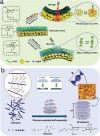Bioinspired Multi-Stimuli Responsive Actuators with Synergistic Color- and Morphing-Change Abilities
- PMID: 34114362
- PMCID: PMC8373155
- DOI: 10.1002/advs.202101295
Bioinspired Multi-Stimuli Responsive Actuators with Synergistic Color- and Morphing-Change Abilities
Abstract
The combination of complex perception, defense, and camouflage mechanisms is a pivotal instinctive ability that equips organisms with survival advantages. The simulations of such fascinating multi-stimuli responsiveness, including thigmotropism, bioluminescence, color-changing ability, and so on, are of great significance for scientists to develop novel biomimetic smart materials. However, most biomimetic color-changing or luminescence materials can only realize a single stimulus-response, hence the design and fabrication of multi-stimuli responsive materials with synergistic color-changing are still on the way. Here, a bioinspired multi-stimuli responsive actuator with color- and morphing-change abilities is developed by taking advantage of the assembled cellulose nanocrystals-based cholesteric liquid crystal structure and its water/temperature response behaviors. The actuator exhibits superfast, reversible bi-directional humidity and near-infrared (NIR) light actuating ability (humidity: 9 s; NIR light: 16 s), accompanying with synergistic iridescent appearance which provides a visual cue for the movement of actuators. This work paves the way for biomimetic multi-stimuli responsive materials and will have a wide range of applications such as optical anti-counterfeiting devices, information storage materials, and smart soft robots.
Keywords: actuators; cellulose nanocrystals; color-changing; infrared/humidity sensitive; multi-stimuli responses.
© 2021 The Authors. Advanced Science published by Wiley-VCH GmbH.
Conflict of interest statement
The authors declare no conflict of interest.
Figures





References
-
- Wang Y., Guo Q., Su G., Cao J., Liu J., Zhang X., Adv. Funct. Mater. 2019, 29, 1906198.
-
- Qiu X., Guo Q., Wang Y., Huang X., Cao J., Zheng Z., Zhang X., ACS Appl. Mater. Interfaces 2020, 12, 41981. - PubMed
Publication types
Grants and funding
- 51873123/National Natural Science Foundation of China
- 51673121/National Natural Science Foundation of China
- 2021JDJQ0017/Sichuan Provincial Natural Science Fund for Distinguished Young Scholars
- 2017GUIKEAA17202030/Science & Technology Major Project of Guangxi
- 2018GUIKE AA18242006/Science & Technology Major Project of Guangxi
LinkOut - more resources
Full Text Sources
Miscellaneous
